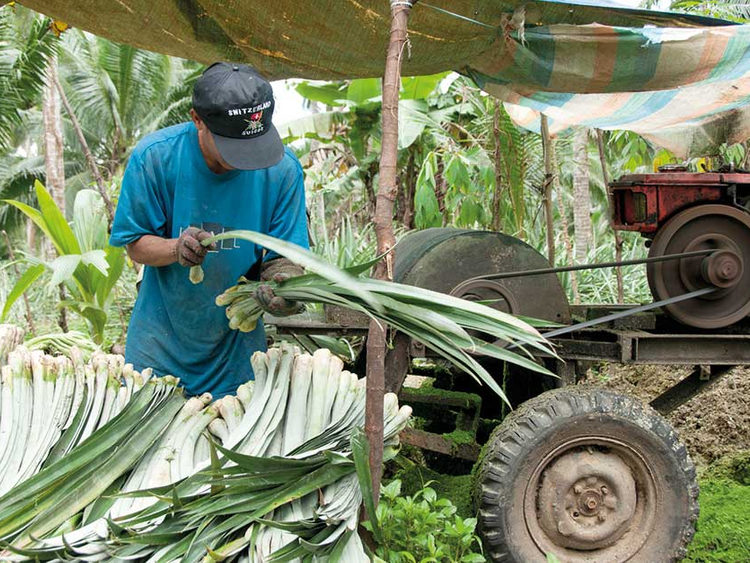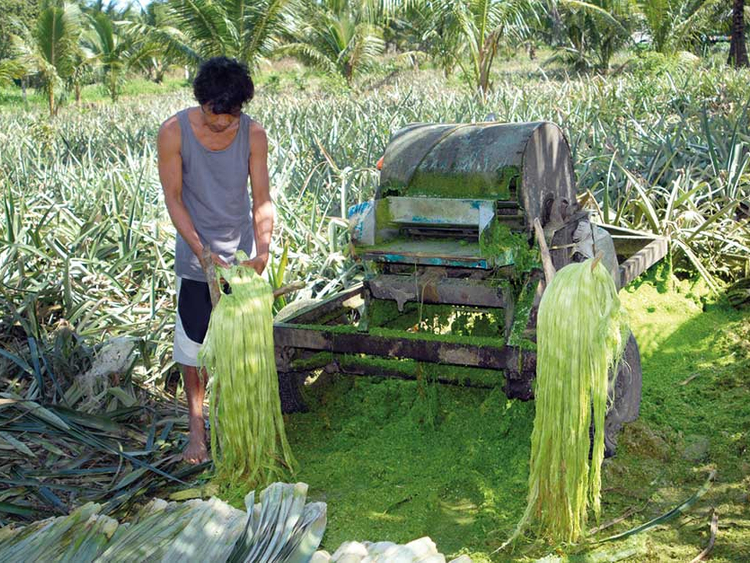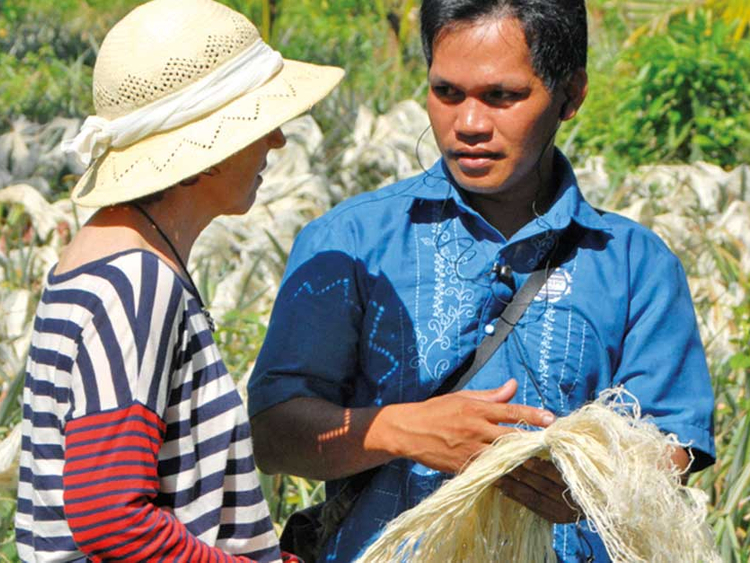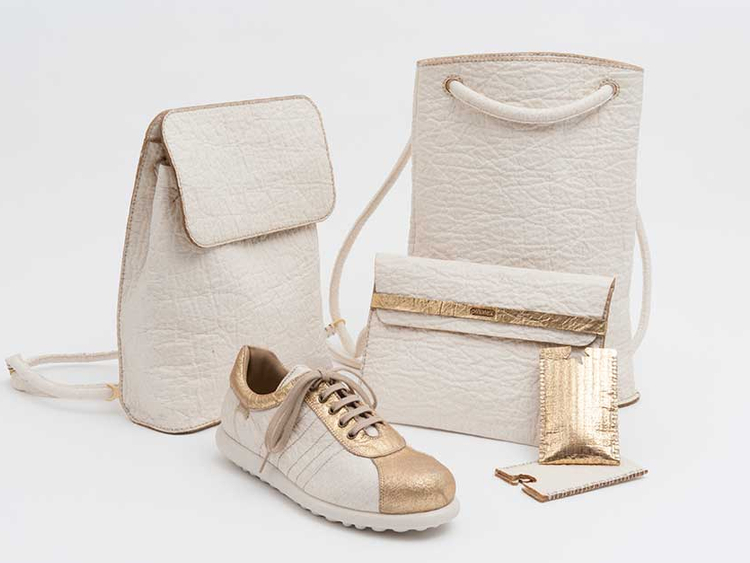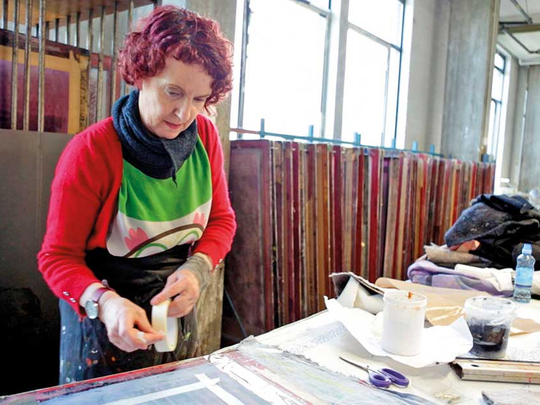
At 63, when most people would be happy to sit back and relax, Dr Carmen Hijosa chose to go back to college to work on her PhD. After five years of doctoral research, she developed Pinatex — a totally new fabric which is strong, versatile, breathable as well as soft, light and flexible. Pinatex can be stitched, cut and printed on.
Resembling leather in appearance, the new material has caused a buzz in the fashion industry as it can be dyed, printed and treated to produce a variety of textures in different thicknesses. It can then be turned into shoes, wallets, bags and furnishings.
But the kicker came when Hijosa revealed that Pinatex was derived from recycled pineapple leaves. These were collected from plantations after the fruit was harvested, then put through a mechanical and chemical process, to emerge as a strong and durable non-woven fabric.
Pina in Spanish means pineapple, so Hijosa christened her fabric Pinatex.
As well as being welcomed by the fashion industry in Europe, Hijosa’s new product also gave the pineapple farmers in the Philippines a new income stream by recycling what was essentially a waste product.
The new textile has been certified as a ‘Vegan Fashion Label’ by People for the Ethical Treatment of Animals (Peta). It received a 2015 Innovation Award — a first for a raw material — and found Hijosa a place among the finalists of the Cartier Women’s Initiative Awards that same year. Pinatex also won the 2016 UK Arts Foundation prize of £10,000 for material innovation.
Hijosa, who grew up in Salas Asturias, a small town in northern Spain, is a post-graduate in textiles from the National College of Art & Design in Dublin. When she was managing her company, Chesneau Leather Goods, dealing in luxury goods in Ireland, she visited the Philippines as a design consultant on a World Bank project. She met weavers working on a traditional fabric made from the fibres of pineapple leaves. Filipino men traditionally wear barong tagalog, a thin, embroidered garment using a craft method utilised for hundreds of years.
“The eureka moment came slowly, while I was working hand in hand with researchers and hand weavers, analysing, testing and working closely with natural fibres,” Hijosa explains in an email.
Having worked in the leather industry for a long time, she was well aware of the ecological damage caused during the tanning process. “At the back of my head I was always looking for an alternative to leather,” she says.
She had wondered whether fibres could be used as the basis for a leather-like product. “Pineapple leaf fibres fit this vision and so the idea of working with them started to take shape.”
The same vision drove her to enroll at the Royal College of Art & Design in London to begin work on her doctorate. “It was exciting and I would do it again today,” she says. “To think that I was going to have the time to become a researcher, fully concentrate on developing Pinatex and be part of the best art and design college in the world, how much better can it get? It was a fantastic challenge.”
She was also driven by the vision that “my work would one day help others to better their future, and help the Earth to heal, even in a small way.”
Hijosa was dogged in her drive.
“While stumbling blocks are part of the research route and need to be climbed over, I have learnt that what today is insurmountable, tomorrow is a juggling act, but with solutions, one just needs to assess, analyse and find a way to implement them,” Hijosa says.
During her research she collaborated with brands like Camper and Puma, who made shoe prototypes, and niche companies like Ally Capellino. She also worked with designers from Royal College of Art & Design to making bags and furniture — all with the intent of exploring the full versatility offered by Pinatex.
Adhering to a strong social and ecological agenda, Hijosa developed the full supply chain for her new wonder textile. In 2014, the then 63-year-old researcher received support from the college to set up her company Ananas Anam to manufacture Pinatex commercially.
The new material was officially launched at an exhibition, The Pine-Apple Show, at the college in December 2014 and featured products made by collaborators including Ally Capellino, Patricia Moore, John Jenkins, Smith & Matthias, Puma and Camper.
Now the vegan leather alternative is available in colours such as charcoal, natural and brown, gold and silver. It has found expression in different forms, ranging from shoes to bags and even watch straps through associations with designers. Recently Lian & Mez, a new German watch label, teamed up to make watch straps from Pinatex.
Bourgeois Boheme, an independent London-based footwear brand for men and women, makes luxury shoes free of animal-derived materials. It is bringing out its Pinatex collection to be showcased at a launch this month.
Hijosa says that one challenge her company faces is to give farmers a steady order to allow them to build supply so that they can build sustainable businesses. “We are very lucky that the Department of Agriculture in the Philippines is a strong supporter of our vision for Pinatex to become a game changer for the pineapple farming communities, and it is helping to make this happen,” she says.
The average pineapple plant has between 30 and 40 leaves around it, each about one metre in length. To produce one square metre of medium weight Pinatex, 480 leaves are needed — or the byproduct of 16 pineapples. In countries like Brazil, Thailand, the Philippines, China, Kenya and Ghana, there is a pineapple crop every 14 months.
Hijosa says that since the leaves are a byproduct of the fruit harvest, they do not need additional land, water or fertilisers to grow, resulting in a low environmental impact compared to other textile crops. “Globally, you’ve got about 25 million tonnes of pineapple waste a year which is either burnt or left to rot, so there is a lot of potential,” she added.
Her present goal is to make Pinatex fully bio-degradable and her team has started the research and development process on that. As her company website declares: “No pineapples are harmed in the making of Piñatex!”
Mythily Ramachandran is a writer based in Chennai, India.



